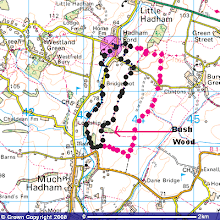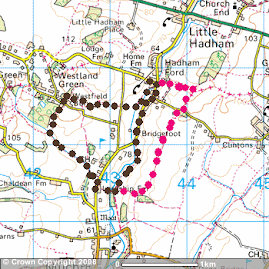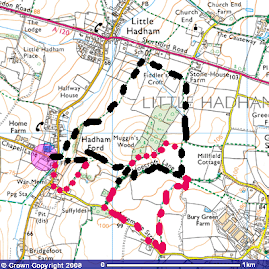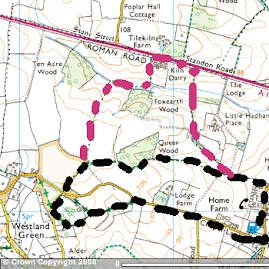As I did with butterflies, thought I would do a brief guide to Dragonfly and Damselfly species that may be encountered locally. Also, conclude with a comment about a few sites where dragonflies can be found, often in good number. Hope it helps and encourages folk to get out to see what is about. A warm, sunny day as from 11am is best for finding them. Windy days they won't fly and rainy days they just hide in reeds, sedge and hedgerows.
Damselflies and Dragonflies are found in the insect order called Odonata (meaning toothed jaw.) This order is then split into 3 further suborders: Antisoptera (Dragonflies) and Zygoptera (Damselflies.) A 3rd suborder is called Anisozygoptera, but these don't bother us and most are extinct.
Zygoptera means paired wings whilst Antisoptera means different wings. In total there are over 5,300 species of Odonata in the world, 120 found in Europe and 38 that reside in the UK along with a few that migrate here each year from the continent.
The main difference between dragons and damsels, apart from size is that damsels rest with their wings folded back along the abdomen whilst dragons have stiff wings that remain at 90 degrees from the body at all times.
They have 3 stages in life: egg, larvae and adult. All eggs are laid in water and with dragonflies, they can remain as larvae for up to 3 years before they crawl up vegetation to emerge as an immature adult.
At this time of year, look for their larval skins, called excuvia, that can be found empty, still clinging to sedge and reed, such as this one I encountered at Bat Willow CP last week. Came across another example yesterday. The creature emerges head first through a hole on the thorax part of the body.
 |
Dragonfly excuvia found at Bat Willow Hurst CP last week.
|
Antisoptera or Damselflies.Going to look at 10 species that are likely to be found around the town and special ones will be mentioned in a gazetteer at the end of this.
Banded demoiselle:
The easiest damselfly to identify. Male is electric metallic blue whilst female is metallic green. Found along river banks and larger ponds. Frequently rests on the top of leaves and sedges. Male shows a dark patch on the wing, easily visible to the naked eye whilst in flight or at rest. Presently very common along the banks of the Stort south of Twyford Locks.
Flight season is early June through until mid August, with the majority being on the wing mid June to early July.
 |
| male Banded demoiselle |
Emerald Damselfly:
Flight period July through until early September. The male is metallic green, the female a duller green. Can be found in ditches, ponds, lakes and canals, rarely running water such as rivers. Note that there is a black area towards the wingtip. This is called the pterostigma and is thought to help with balance when the insect is gliding. Always good to check this feature, as different species have different colours which can aid identification. Not a common damselfly around Stortford thought it will be seen. Note the blue abdomen and the fact it is white underneath.
 |
| Emerald damselfly |
Willow emerald Damselfly:
A recent addition to the British list. An excuvia was found in Kent in 1992 but it wasn't recorded on the wing until 2003. Now found all around Stortford, arriving for the first time in Millennium Wood in 2019. An exciting discovery.
Shows a green abdomen and green thorax and head, too so can be distinguished from the Emerald damselfly. A late emerging damsel, often not seen until late August and throughout September. This lateness also helps with id as most similar species will have finished when this emerges. Usually found near ponds, lakes and rivers. First recorded in Herts at Amwell and has spread rapidly from there.
Note the pale coloured ptersostigma.
 |
| Willow emerald damselfly |
White legged damselfly:
Distinctive legs as the name implies are a creamy white and can be seen clearly. Also, when looked at more closely, the tibia or lower part of the leg shows long hairy bristles.
The abdomen is blue and black whilst the thorax on an adult is striped green and black. Flight season is June through to July.
Not a common damselfly for our area. Only site I know is Hatfield Forest where the immature can leave the emergence site and fly several 100 metres away to rest in grassy areas along the rides of the forest. I first came across this species in 2018 in the forest and this was stated to be a new species for Hatfield Forest although it had been reported before and just overlooked.
It prefers slow flowing water such as the ditches at the end of Hatfield Forest lake.
Note the pterostigma is a pale orange. Be good to find this species elsewhere, so do check blue damselflies carefully. Photos here of the one I found in the forest. This is a young, or teneral specimen, yet to get the colour to the abdomen.
 |
| White legged damselfly |
 |
| Note the legs colour and bristles. |
Large red damselfly;
Another easy to identify creature as, to all intents and purposes, the only red damselfly you'll encounter. Usually the first to emerge, often in warm weather at the end of April and can be found right through until mid to late July. A damselfly that can be found in gardens, away from water but will happily breed in the smallest of garden ponds. Also found along banks of larger ponds and lakes, rarely rivers.
 |
| Large red damselfly from our garden in 2020. |
 |
| Better closeup showing black pterostigma |
Now we come to a pair that can be a confusion species. With the next two, both ubiquitous around Stortford, a reasonable photo of the abdomen will aid identification as described below.
Azure Damselfy:
The stereotypical blue damselfly showing black markings. Very similar to the Common blue (see below) but one or two pointers.
The main id aid is the pattern on the first 2 segments of the abdomen next to the thorax. On Azure this looks rather similar to the Honda car logo, a sort of H shape, or similar to rugby posts where the mark above the crossbar is longer than the one below. Also, 90% of female Azure damselflies are green whereas very few Common blue damselflies are anything but blue. Easy to spot when they are flying in tandem.
Azures emerge late May and will be on the wing until early August. A really common insect that will be found near any water course, pond, ditch, lake or canal. Can be encountered in their 100's, usually consorting with Common and Blue tailed damselflies.
 |
| Azure damselfly |
 |
Close up of abdomen segments.
|
Common Blue Damselfly:Another blue and black insect, this time, usually showing a black club shape on segment 1 of the abdomen. Also, sometimes clear, other times not, segments 8 and 9 can appear to be a brighter blue colour. Female invariably blue as well.
Flight times and habitats the same as azure although whilst azures rarely stray too far from water, Common blues can be found in grassy areas some distance from their emergence point.
 |
| Common blue damselfly, just see the mark on segment 1, clearly not an H shape. |
 |
| Typical roosting position for Common blue. |
Blue tailed damselfly:
Another relatively easy species to id. Basically a long black abdomen with segment 8 being bright blue. Consorts and flies with both Common blue and azure, with the same flight periods. As Rick Stead and I found last year, there are an array of colours for this species, with them ranging from the usual, shown below to orangey red shades, purple shades and green ones but all show the blue segment.
 |
Blue-tailed damselfly.
|
Red eyed damselfly:
A relatively common species but not often seen as this species, and the next one, Small red eyed damselfly are rarely seen on land and more than likely resting on floating vegetation such as weed and pond lily leaves. Therefore, best viewed with binoculars when the red eyes will be apparent.
Flight period is mid June through until August.
A long black abdomen with blue segment 8 can give the impression of Blue-tailed but the eyes are easy to see, if red then that rules out Blue-tailed.
 |
| Red eyed damselfly |
Small red eyed damselfly:
Basically a smaller version of above. First discovered in Essex in 1999 and a large influx from the continent in 2001 meant it rapidly populated most of the south east and can be found at many ponds and lakes around Stortford. Again, prefers floating vegetation and can be tricky to sort out these two species. One is obviously larger but the main thing for id is that the Small red-eyed damselfly curve their abdomen upwards when resting. With binocular views, check the sides. In small red-eyed, segments 2 and 8 are entirely blue whereas in Red-eyed they are black.
Flight period as with Red-eyed. Now well established locally.
 |
| Small red-eyed damselfly with Common blue in the foreground |
.
Other species are possible so well worth checking. With patience, photos can be taken of these species relatively easily and even a reasonable phone shot should be good enough to secure identification.
Useful Field Guides:
There are many books available for dragon and damselfly id, many are not comprehensive whilst others cover the whole of Europe. I highly recommend Field Guide to Dragonflies and Damselflies of Great Britain and Ireland by Steve Brooks and illustrated by the superb Richard Lewington. A concise yet detailed guide, brilliantly illustrated. ISBN 0-953-13990-5
There is also the much more detailed one that covers Europe by Klaas-Douwe B Dijkstra. With over 160 odonata species covered it can become very baffling for the beginner, especially as the English names are in fact the European names, which differ to our ones. eg in Europe, Common bluetail, here Blue-tailed damselfly. I do have a copy of this which I use for European sorties, especially The Camargue where in August there are literally 100's of odonata every 10 yards of many species. I wouldn't recommend this apart for foreign travel.
Just out of interest. I spent an afternoon doing river monitoring in a river in St Albans with Steve Brooks. He is the leading Odonata specialist at the Natural History Museum and admitted he can "only" identify 200 of the possible 450 midge larvae species in Britain!! Rather shabby, I thought lol.
Anisoptera or Dragonflies:
As above, I shall just look at the most likely insects that will be found around town. Others are, yet again possible so always worth checking, especially after hot southerly winds in July and August where species such as Red veined darter or Lesser emperor may have migrated over from central France and the Low Countries.
9 species outlined here.
Migrant hawker:
A medium sized dragonfly, male showing a blue and black abdomen whilst the female shows yellow markings on black. Flight season begins around early August and can last until October and the first frosts. A common sight away from water, patrolling hedgerows. So called, as up until the 1940's it was indeed migratory to the UK but is now well established.
Similar to the Southern hawker, the diagnostic feature is the shape on segment 1 of the abdomen, a yellow mark in the shape of a golf tee whereas the similar Southern hawker displays a triangular shape.
Side views will show an array of yellow on the thorax whilst down the side of the abdomen will be blues and dark browns/blacks depending on how mature the insect is. Shows orange pterostigma.
 |
| Migrant hawker: note the yellow golf tee shape between the 2nd set of wings. |
Southern hawker:
Not dissimilar to above but shows the yellow triangle.Female is green and black whilst the male is green and black with blue showing on the final 2 segments of the abdomen. Flight period July until the end of September. These insects, mainly males, have a great habit of coming to inspect you, fluttering on noisy wings just a metre in front of you whereupon you may notice the slight downward curve of the abdomen, lacking in Migrant hawker.
Found away from water, along woodland rides and in urban gardens. A really colourful insect. Has dark pterostigma
 |
| Southern hawker, showing yellow triangle. cf Migrant hawker |
 |
| Lateral view of Southern hawker |
Brown Hawker:
Unmistakeable insect with its large size, boisterous behaviour in chasing anything that flies over his patch of water and bright yellow/light brown wings. Side view shows patches of blue. Only confusion species would be Norfolk hawker which has green eyes, no colouration on the wings, is rare in Herts and has a different flight period. Apart from that, they are tricky!!
Often seen gliding low over the surface of large ponds before looping up, turning and then continuing to patrol his territory.
Flight period mid July to early September.
 |
| Brown hawker. Note colouration of wings. |
Emperor:
Another fairly easy insect to id. Often seen patrolling low over the water, both ponds and rivers showing its blue abdomen and green thorax and head in the male and a more all green female. Large dragonfly with a flight period between mid June and mid July. Plenty along the River Stort this morning south of Twyford Locks. Rarely found away from water and a common enough dragonfly for all to see and identify. Like all aspects of nature watching, learn the common ones and then you'll notice others that are different.
 |
| Male Emperor patrolling low over the water. Note curve in abdomen |
 |
| Female, showing more green, egg laying (ovipositing) at Bat Willow Hurst CP 13th June 2021. |
Four-spotted Chaser:
Medium sized dragonfly, flying as from early June through until early August. Easily identifiable when at rest as shows a spot on the leading edge of the wing, midway from tip to thorax as well as the dark pterostigma. This gives the impression of 2 spots along the leading edge. Immatures can be found roosting in grass or on leaves of trees and hedges. These are a bright yellow/orange with a black section at the end of the abdomen whilst the mature males are a greeny brown with yellow markings. Again, a fairly easy one to identify.
These are easy to photograph as they frequently return to the same roost site, usually the top of dry vegetation or a twig where they rest with their back to the sun, offering great shot opportunities. Plenty at Bat Willow CP yesterday.
 |
| Immature, probably female |
 |
2 spots per wing easily visible.
|
Broad bodied chaser:Another easy one as it does indeed have a broad abdomen, brown in the female and bright blue in the male. Both show yellow markings along the side whilst the immature is a golden yellow. Thorax of male is brown when viewed from the side.
Flight season June and July and can be found near ponds and pools, rarely rivers. Female can look like a huge and very chunky wasp.
 |
| Immature Broad bodied chaser |
 |
Adult male. Note black on the wings and almost no black at the tip of the abdomen.
|
Black tailed skimmer:Another blue bodied insect in the male and a yellow brown in the female. Much slimmer than the Broad bodies chaser and the first thing to note on the male is the amount of black on the tail. Found near lakes and ponds, this dragonfly prefers to rest on the ground, frequently on warm stones. From here, it will go off on patrol before returning to the same spot. Can be confused with Broad bodied but as both species are often found together it becomes relatively easy to separate them by abdomen size and blackness of abdomen.
Flight period is again June and July.
 |
| Black tailed skimmer, lateral view. Note yellow on leading edge of wing. |
 |
| Male Broad bodied Skimmer |
Common darter:
A small, vibrantly red dragonfly, that flies as from mid July right through to the first frosts. Similar to the Ruddy darter, the diagnostic feature for identification being that the Common darter shows yellow stripes on the legs. Often, also relatively easy to see, is that the abdomen is parallel. Females are yellow as are the immatures but still show the diagnostic leg colouration. A common species of pools, lakes, rivers and gardens.
On a warm day these insects can be quite inquisitive and if you mop the sweat from your brow on to a finger they may alight to use the salt minerals, permitting a great photo
 |
| Common darter, note yellow on legs and straight abdomen |
 |
| Common darter |
Ruddy Darter:
Similar to the Common darter with 2 differences. One, the legs are all black and secondly, it often shows a "pinched waist" along the abdomen that gives it a slight clubbed look. a few centimetres shorter than the common but really need to see both at the same time to notice this feature. With good views whilst at rest, possible to pick out a slight yellow around the base of the wings near the thorax, but this can fade with age.
Flight period begins a little later, towards the end of July and lasts until the first frosts. Again found by lakes, rivers and ponds and is a garden visitor.
 |
| Club shaped abdomen visible here. Ruddy darter |
I have just touched on details here. Variations do occur, immatures can be tricky to identify and with damselflies, the teneral, (or young), tend to whirl around grasslands with wings going in all direction. Many will not have got full abdomen colour and can be confusing, but don't be put off. At this time of the year there will be so many to see and identify. Like all identification skills, it does get easier.
Also, it is relatively easy to get great photos of them when roosting and, with skill and the correct camera gear, possible to manage some fantastic in flight shots as shown on Stortford Nature Facebook pages.
Finally, a brief list of better dragonfly places to visit locally. However, the best site around is the Dragonfly walk at Amwell Nature Reserve, Well worth a visit and there is a useful information board with illustrations of all that can be seen there, which is most helpful. Highly recommended.
Bat Willow Hurst CP: the most southerly pond here holds great numbers of both dragons and damsels at present. Ideal for a beginner as you won't be overwhelmed with a plethora of species and small enough area to check thoroughly. Offers great photo opportunities.
Stansted Airport Lagoons: A good site. Just sit near the reeds and sedges around any of the lagoons for good views of a fair few species whilst also check the grassy banks for immatures and damselflies.
Bourne Lane/Henry Moore Estate: Another super lake, covered in lily leaves and vegetation. Not everyday you can sit watching dragonflies whilst sitting in the shade afforded by a huge Henry Moore sculpture. Directions: Through Much Hadham towards Widford. Just before the incline into Widford there is a lane (Bourne Lane) on your left. Turn here and drive 100 yards or so. On your left is an opening by a house. Park here, walk up the path. This forks: straight on and left. Carry straight on up a slope until you enter a grassy field through a metal gate. This field has concrete drains scattered around, ventilation as it was a land fill site. Walk directly across the field to an opening in the row of trees on the far side. Through here and the lake is on your right.
Thremhall Park: As yet, I have not looked around here for Odonata but on previous spring and winter visits it looked to have potential. Bonus is that there is a cafe on site, too. One lake is in the trees on your left as you drive in whilst a more promising stand of water can be found the far side of the car park. Need to pop into the cafe to register your car reg plate but no charge for parking there. I shall check it out soon, possibly tomorrow afternoon. (15.06.21)
River Stort: I find the best stretch for both damsels and dragons is between Twyford Locks at Pig Lane and Spellbrook Locks. Today, loads of Banded demoiselles, several Emperor and azure damsels. Always worth a tow path walk.
Hatfield Forest: The main lake is not up to much but the small lake beyond the Shell house is great for several species of dragonfly, particularly Brown hawker. Also, as you drive in towards the cafe and car park, the area at the end of the lake, covered in reeds is where the White legged damselflies emerge. They then disperse into the rides on your right. Well worth checking any time now..
Good luck and Good dragon hunting.
 |
| Female Banded demoiselle. |

















































































































